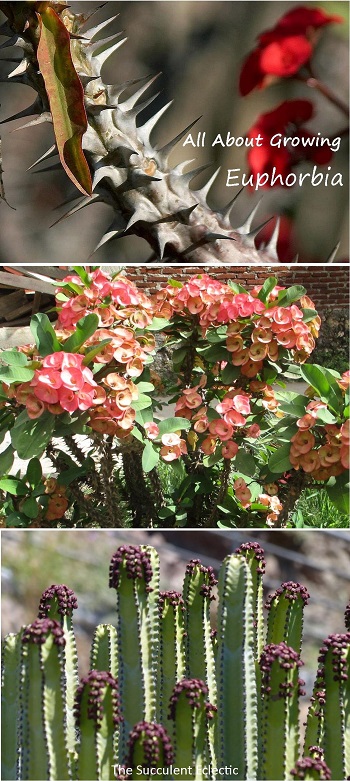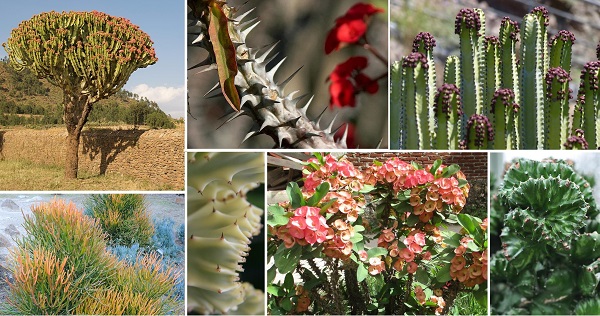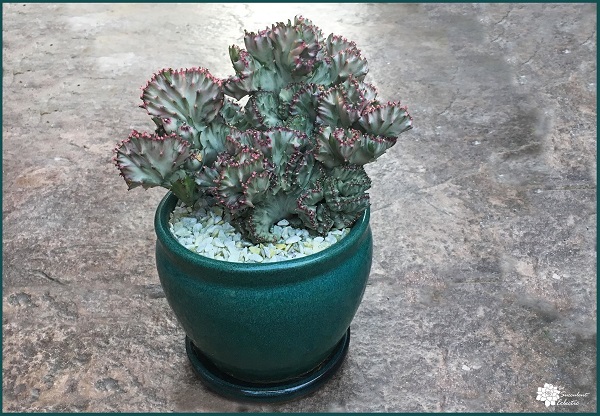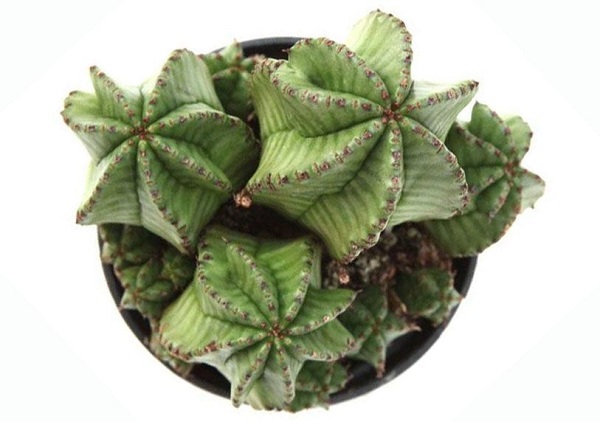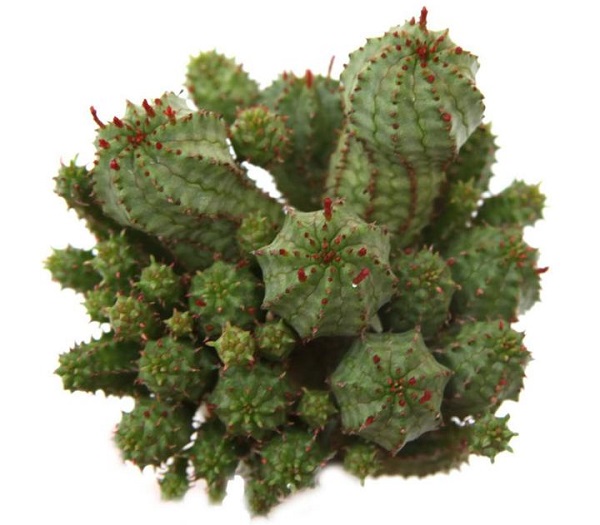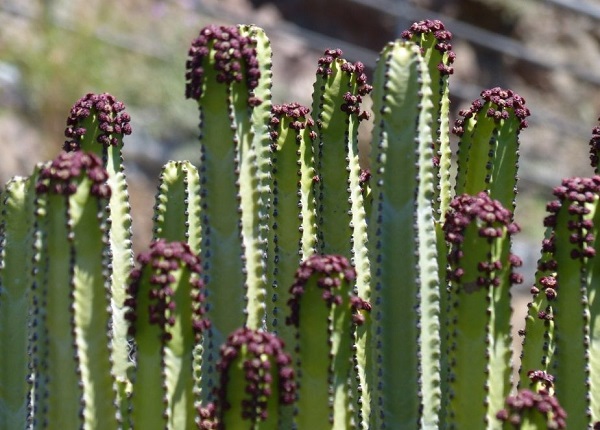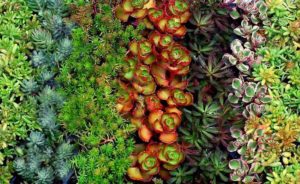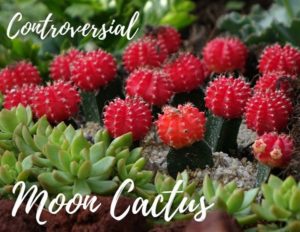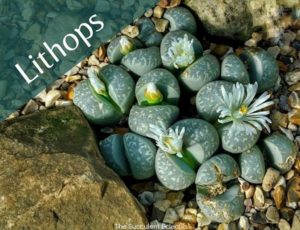Euphorbia (You-FOR-bee-ah) is a huge genus of diverse and dramatic flowering plants with 2,000 species. Some are tiny annuals, others form huge trees, with every size in between well represented. Most are succulent, though some, like the poinsettia, are not. Euphorbia varieties are found all over the world, with concentrations in the temperate regions of Africa and the Americas. This is a strange and enigmatic group of plants, often confused with cactus, for the many prominent thorns many euphorbias produce. Always treat this plant with respect. In addition to many producing thorns, all euphorbia are toxic and produce a milky white, latex sap that can be very irritating or downright caustic to some people. So – is a plant this dangerous really worth growing? Let’s see why many gardeners answer a resounding Yes!
All About Growing Euphorbia
In this Post We'll Cover:
{Please note, some links in this post may be affiliate links to sites that pay me a small commission if you click on the link and make a purchase. This commission is at absolutely no cost to you. I only recommend products and companies that I have worked with and truly love! ~Kat}
Euphorbia Cactus Conundrum
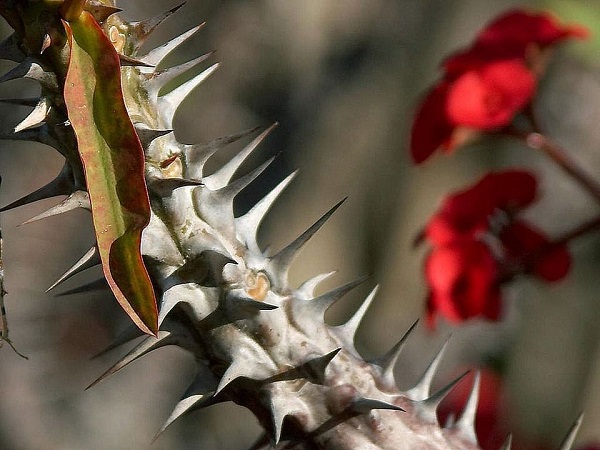
The wicked sharp thorns of the Euphorbia milii above clearly demonstrate why so many confuse euphorbias with cactus. While they are botanically distinct, the similar traits of euphorbia and cactus resulted from millennia of adaptations to similarly harsh environments. This is known as convergent evolution. Both succulent euphorbia and cactus store water in their stems to support the plants in times of drought. Both developed long, sharp spikes to protect their water stores from foraging animals, and to protect the plant against blazing heat. The spikes produce a small bit of shade, while breaking up the airflow around the plant, limiting moisture loss to the wind.
The Differences Between Euphorbia and Cactus
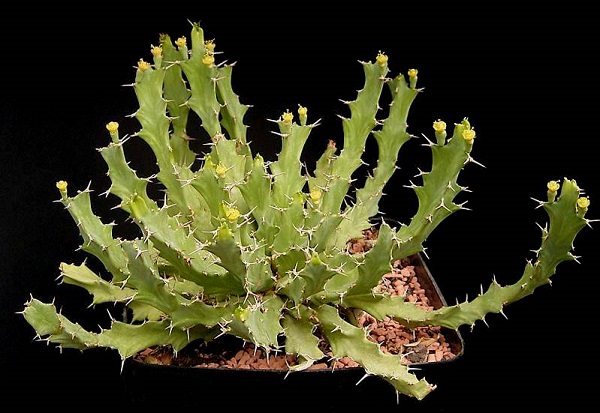
Although all cactus are succulents, not all succulents are cactus. Most euphorbias are succulents. Many of them look like cactus, and are typically referred to as “euphorbia cactus”, but no euphorbia is biologically a true cactus. Confused yet? Cactus all share a defining characteristic — areoles. This is a highly modified branch that appears as a small, round bump, that supports blooms, spines and shoots. Even spineless cactus all have areoles, but no euphorbia does. However, many euphorbia cactus do have thorns growing from round bumps. These bumps do not produce blooms or shoots and are not considered areoles.
Cactus spikes are spines, which are modified leaves. They are typically quite narrow, and needle-like, looking as if they were pushed through the skin of the cactus from the other side. Cactus spines always develop from areoles. The spikes on euphorbia are thorns, which are modified stems or branches. They are typically much broader at the base and look as though the skin of the plant was pulled to grow into a thorn. While some euphorbia thorns appear on bumps, many do not. I confess, I am not great at telling the difference between euphorbia bumps and cactus areoles.
So, onto clearer distinctions between euphorbias and cactus. When in bloom, they are easy to tell apart. The flowers of cactus are complex and typically large and quite flamboyant. The flowers of euphorbia are quite small and simple, with only female or only male parts to each flower. Typically, the colored “petals” of euphorbia flowers are actually bracts, or modified leaves, and not true flowers. More on euphorbia flowers below. The final distinction between the two groups is their sap. Cactus sap is usually quite clear, while euphorbia sap is characteristically milky white and quite toxic. More on this to follow.
Euphorbia Poisonous Sap
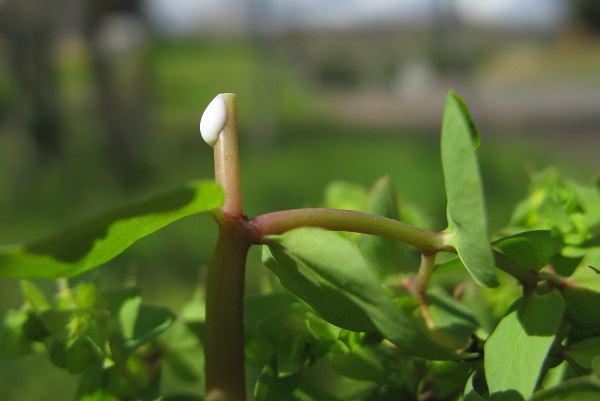
When you cut any euphorbia variety, it will bleed copious amounts of milky white latex sap. Many common names for euphorbia varieties, like African milk tree or milk bush, refer to the white sap. This sap can be highly irritating to many people, causing severe skin rashes. A tiny brush with your eyes, nose or mouth will be terribly painful even for those not sensitive to it on their skin. Take great care with this sap. Your skin may take as much as an hour to react even if you are very sensitive to it. And if you get sap on your shirt, and then later pull it off over your head, you risk getting sap in your eyes. Do not take that risk!
Euphorbia sap is toxic. It was developed as a defense against animals desperate to feed on the moisture stored within the stems of the plant. The sap also has both antibacterial and antifungal properties that rapidly heal any injury to the plant. When you take euphorbia cuttings, there is no need to wait a few days for the cut to heal over. The sap ensures the cutting remains healthy while it begins to root.
The fierce thorns and toxic sap make euphorbia a plant that must be treated with respect. Take care when pruning this plant, and keep it out of the reach of plant-eating pets or small children. But there is no need to fear this plant. Many, many garden plants are as toxic or more so than euphorbia. Be prudent and take precautions. And you may well appreciate how highly resistant all euphorbia varieties are to deer, rabbits, squirrels and gophers, thanks to those thorns and sap.
Euphorbias are All About Texture!
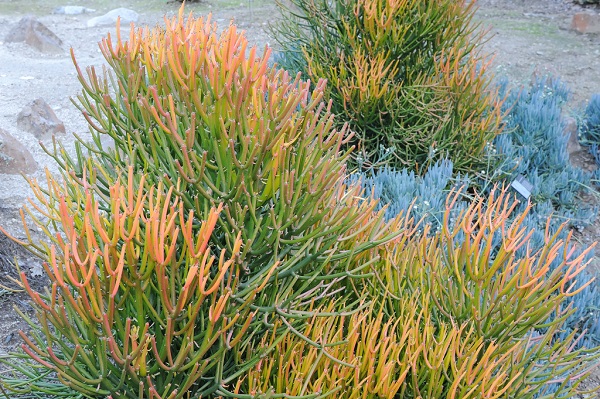
A primary allure to growing succulent euphorbias is their fabulous texture! Here, Euphorbia tirucalli ‘Sticks on Fire’ looks like a sea coral adding glorious stress coloring and airy, whimsical texture to the garden. Including euphorbia varieties in your garden or mixed arrangements lends drama and excitement with their unusual forms. Euphorbia cactus thorns add an edgy vibe to mixed rosettes and other smooth succulents.
Euphorbia Flowers
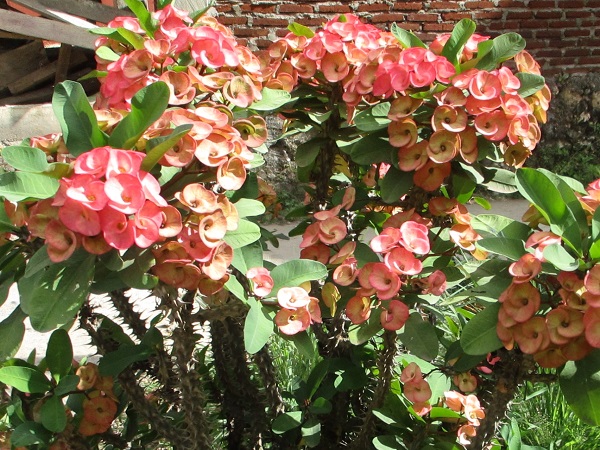
Much of what we see in the showy and long-lasting blooms of euphorbia varieties are not truly flowers. These are colorful bracts or modified leaves that surround the tiny, highly minimalized euphorbia flowers. Each flower is male or female, with only the essential parts required for sexual reproduction. The flowers have no true petals or sepals or nectar to attract pollinators. The male flowers have a stamen, and female flowers have the pistil — and that is it. Although euphorbia do produce nectar to appeal to bees, it is produced and bourne outside the true flowers.
These unusual bloom structures lead to an extended flush of the colorful bracts most people look for in blooming plants. In fact, the Euphorbia milli shown above, and commonly called the Crown of Thorns plant, flowers nearly year round!
Euphorbia Care & Sun Exposure
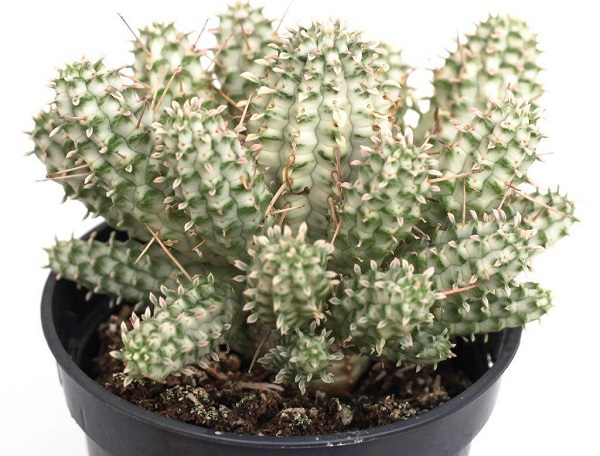
Getting the sun exposure right is always important for succulents, but euphorbia are less likely to stretch in lower than ideal light. Start your euphorbia varieties in morning sun with protection during the heat of the day, to avoid sunburn. Watch for signs of stress, then slowly, increase the sun exposure until both your plant and you are satisfied with its location.
My thanks to Leaf and Clay for the use of this photo of Euphorbia mammillaris variegata!
Euphorbia Care
Euphorbia Soil
Like all succulents, euphorbias do best with a fast-draining soil that is nutritionally lean. I incorporate a good amount of pumice in the soil for my succulent euphorbias, to increase the availability of air to the roots, and to keep the drainage running smoothly. Here, I have added an inorganic top dressing. This prevents pests from laying eggs in the soil, interrupting their life-cycle. It keeps soil from splashing up onto the plant when I water, and also keeps moisture from evaporating too quickly on hot days. And let’s be honest – it looks really great! (I have been asked several times for links to buy this awesome cool plant. I bought mine locally, but I have found some great options to order Euphorbia lactea cristata online at Amazon!)
Watering Euphorbia
Like all succulents, euphorbia store water for the plant’s future use. Similar to cactus, euphorbia store the water in their stems, rather than in their leaves. Proper watering is crucial for these plants. Be sure your euphorbia is growing in a good, fast-draining succulent soil. Then water thoroughly, and all the excess water to drain. When the soil is fully dry, again water thoroughly, until the water runs from the drainage holes. This “drought and drench” cycle mimics the natural rainfall these plants experience in their native land. For euphorbia to look their best, they do require a bit more frequent watering than the cactus they so closely resemble. Please click here for an in-depth review of how to water succulents, and to recognize the signs that they need more water.Thank you, Leaf and Clay for the use of this photo of Euphorbia ‘Tanzanian Zipper Plant’.
PropagatingPropagating (PRAH-puh-gate-ing) a plant is to grow another p... Euphorbia
While euphorbias can always be propagated by seed, it is a very long, slow process, and the seeds are often very difficult to find. A far quicker and easier approach is to take cuttings and root them. Taking cuttings from euphorbia cactus is a bit different from other succulents, but overall, it is the same process. Euphorbia cuttings do best when taken in the spring or summer.
Be sure to use a good pair of gardening gloves, to protect your skin from the sharp thorns, and the toxic sap. Protection is good, but being careful is even better. Remember that each cutting will bleed sap quite heavily, and it is critical not to get any in your eyes, For taking your cuttings of most euphorbias, I use my favorite utility knife, or a sharp and dedicated steak knife will do a good job.
Make your cuts where two stems or branches meet at a joint. If this is not possible, or in the case of root rot, cut off the top portion of a stem for your cutting, leaving about 5 or more inches to your cutting. Lots of sap will bleed once you make your cut. Pop the cut end into a bowl of water while you continue to work. This will quickly stop the sap from flowing. Spray the cut end that remains on the plant with water to stop the sap running there, too. Bury the bottom 2 inches of your cutting in dry succulent soil (the bottom inch for smaller euphorbias). There is no need to wait and allow the cutting to heal over. The sap will prevent rot from setting in. Set the cutting in its dry soil aside, in a shaded spot for a week or so, then water lightly. Keep the cuttings in bright shade for another month, watering when the soil is fully dry. By this time, you should have a good set of new roots developing! Transplant your new euphorbias, and slowly acclimate them to more light.
This photo of Euphorbia monstrose provided courtesy of Leaf and Clay. Thank you!
Euphorbia Pests
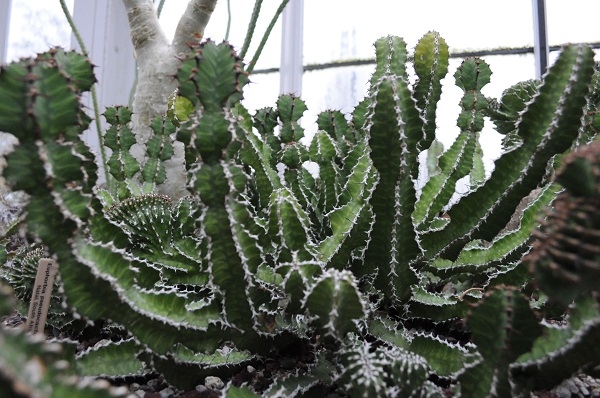
Between the wicked sharp thorns and toxic sap, few pests will bother your euphorbia. Occasionally, mealybugs or spider mites may settle in. These can be dispatched with a bit of isopropyl alcohol or insecticidal soap. Just be sure to apply soap or alcohol out of the direct sun, and protect the plants from sunlight for 24 hours. Better yet – learn to prevent insects from bothering your succulents in the first place!
I hope you have enjoyed learning about the edgy and enigmatic euphorbia. I’d love to learn if you plan to grow it yourself. Please take a moment to leave me a comment and let me know! By all means, treat euphorbia with respect, and protect pets and small children from tangling with it. But there is no need to fear it. Instead – enjoy it! ‘Til next time…
Happy gardening!
P.S. Please subscribe to my FREE course, 7 Steps to Succulent Success, for a complete guide to succulent care! Thank you!
P.P.S. Why not join my Facebook Group for succulent lovers? We talk about succulent care, propagation, succulent identification, and design. It’s a warm and welcoming group that would love to meet you!
